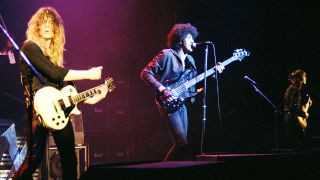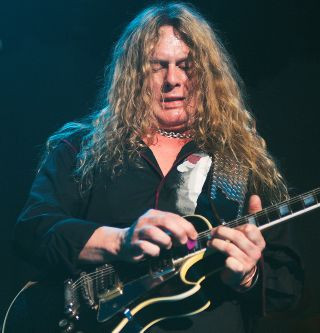On January 20, 2025, the world of rock guitar lost a true icon with the passing of John Sykes at the age of 65 after a battle with cancer. For many guitarists, including myself, John Sykes was more than just a musician; he was a profound influence. His emotionally charged lead guitar work, masterful riffing, and signature larger-than-life guitar tone resonated deeply within guitar playing circles and beyond. Despite his immense talent and contributions, John Sykes, the guitarist, remained criminally underrated in the wider music landscape.
John Sykes was truly a rock guitarist’s guitarist. He possessed a rare gift for crafting instantly memorable riffs and writing exceptional songs. His fretboard hand vibrato was legendary – wide, soulful, and delivered with unrestrained passion. Listening to John Sykes, you always got the sense he was giving it his all. This raw energy and excitement are palpable and continue to inspire, even when listening through modest smartphone speakers. Tracks like Don’t Stop By, Gangland, and Do It Good from his Tygers of Pan Tang days, Crying in the Rain, Give Me All Your Love, and Bad Boys with Whitesnake, and Riot, Billy, and Cry for Love from Blue Murder all have a similar effect – they ignite a fire and make you want to pick up your guitar and play.
Beyond his instrumental prowess, John Sykes was also a remarkably talented vocalist. And if that wasn’t enough, he possessed striking stage presence and undeniable good looks. My first encounter with John Sykes was in 1980 in Manchester, England, when he was performing with Tygers of Pan Tang. The experience was nothing short of transformative. Even as a new member of the band, he commanded the stage and captivated the audience. At the time, we were the same age, but his talent and skill were already in a different league. The albums Spellbound and Crazy Nights, released by Tygers in quick succession in 1981, solidified what I witnessed that night – John Sykes was not just having a good night; this was his standard of excellence.
 John Sykes performing with a guitar
John Sykes performing with a guitar
(Image credit: Getty Images)
This impact wasn’t limited to just me. Marty Friedman, in a conversation with Eddie Trunk, recounted the seismic shift John Sykes created with the Spellbound album. Friedman stated, “When John Sykes came out on the Spellbound album, it was like, ‘This was a game changer for me.’ He was the first guy in that genre that I heard that I was like, ‘Wow – these lead guys can really take an exciting part of the band’s sound.’” Friedman continued, emphasizing Sykes’ broader influence: “He was an extremely important influence on myself, and a lot of the people I’ve met over the years. Everybody in the world of heavy metal, hard rock and guitar owes a lot to him.”
John Sykes’ tenure with Tygers of Pan Tang was brief but impactful. He then collaborated with Phil Lynott in 1982, co-writing the memorable single Please Don’t Leave Me. This led to an invitation to join Thin Lizzy. The album Thunder & Lightning and the subsequent tour in 1983 marked the end of Thin Lizzy as Phil Lynott decided to close that chapter. Thunder & Lightning remains a personal favorite Thin Lizzy album, and John’s guitar work, particularly his riffs, solos, and tone in Cold Sweat, set a new benchmark for guitar excellence.
In early 1984, John Sykes resurfaced with Whitesnake, injecting new energy into David Coverdale’s band. His contribution was instrumental in the success of the Slide It In album in America. Following the tour, Sykes partnered with Coverdale to co-write nine songs for the 1987 Whitesnake album. This album became a massive hit, selling over 8 million copies in the US alone and cementing Whitesnake as a global rock force.
 John Sykes playing guitar on stage
John Sykes playing guitar on stage
(Image credit: Getty Images)
Ironically, despite his pivotal role in the album’s creation, John Sykes and the rest of the band were dismissed by Coverdale before its release. However, the music spoke for itself. John Sykes’s unmistakable guitar style and songwriting prowess were evident to everyone, solidifying his status as a true guitar hero. While his soloing on Whitesnake is breathtaking, his rhythm guitar work, songwriting, and arranging are equally noteworthy. Steve Vai, in a recent interview with Cassius Morris, lauded John Sykes, saying, “He was such a phenomenal rock guitar player. When that album came out we were all just stunned. He really captured that audio real estate with a guitar tone and a playing style that created a fever. He was really a great player and a great guitar orchestrator.”
John Sykes’ next venture was Blue Murder, a power trio supergroup featuring Tony Franklin on bass and Carmine Appice on drums. Their self-titled debut album in 1989 showcased the full spectrum of John’s talents. Despite critical acclaim, the album didn’t achieve the commercial success anticipated, and the original lineup eventually dissolved in the early 90s. Sykes continued with a new lineup, releasing Nothin’ But Trouble in 1993 and the live album Screaming Blue Murder: Dedicated to Phil Lynott in 1994. However, Blue Murder was dropped by their label and subsequently disbanded.
 John Sykes performing live with a band
John Sykes performing live with a band
(Image credit: Getty Images)
John Sykes then signed a deal in Japan and released his debut solo album, Out of My Tree, in 1995. Around the same time, he reunited with former Thin Lizzy members Scott Gorham, Brian Downey, and Darren Wharton for a touring version of Thin Lizzy, taking on lead vocal duties himself. He released three more solo albums – Loveland (1997), 20th Century (1997), and Nuclear Cowboy (2000) – as well as a live album, Bad Boy Live! (2004). A Thin Lizzy live album, One Night Only, was released in 2000. While Thin Lizzy continued to tour with various formations, John Sykes stepped away in 2009, citing a desire to focus on his solo material. However, he subsequently withdrew from the public eye.
Although I never had the opportunity to meet John Sykes personally, his guitar playing and songwriting have had a lasting influence on me and countless others. His name frequently comes up in discussions about influential guitarists, even in contemporary platforms like my YouTube appearances with “Uncle” Ben Eller and Satchel from Steel Panther, always accompanied by reverence and respect. Timeless, catchy riffs and songs, blistering solos, incredible guitar tone, and that vibrato – wider than a highway – John Sykes offered everything a rock guitarist could aspire to. Rest in peace, Mr. Sykes. Thank you for the extraordinary music, playing, and enduring inspiration you gifted us.

